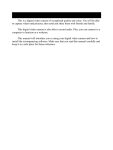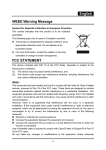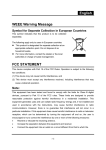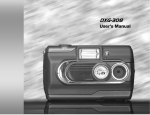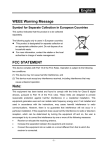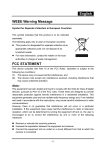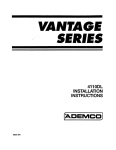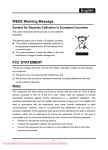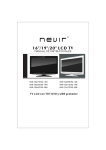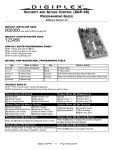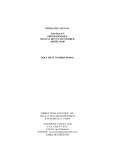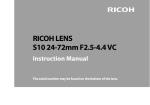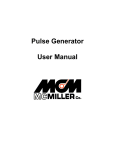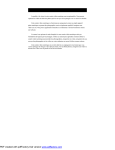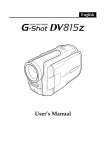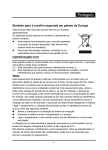Download English WEEE Warning Message FCC STATEMENT
Transcript
English WEEE Warning Message Symbol for Separate Collection in European Countries This symbol indicates that this product is to be collected separately. The following apply only to users in European countries: z This product is designated for separate collection at an appropriate collection point. Do not dispose of as household waste. z For more information, contact the retailer or the local authorities in charge of waste management. FCC STATEMENT This device complies with Part 15 of the FCC Rules. Operation is subject to the following two conditions: (1). This device may not cause harmful interference, and (2). This device must accept any interference received, including interference that may cause undesired operation. Note: This equipment has been tested and found to comply with the limits for Class B digital devices, pursuant to Part 15 of the FCC rules. These limits are designed to provide reasonable protection against harmful interference in a residential installation. This equipment generates uses and can radiate radio frequency energy and, if not installed and used in accordance with the instructions, may cause harmful interference to radio communications. However, there is no guarantee that interference will not occur in a particular installation. If this equipment does cause harmful interference to radio or television reception, which can be determined by turning the equipment off and on, the user is encouraged to try to correct the interference by one or more of the following measures: Reorient or relocate the receiving antenna Increase the separation between the equipment and receiver Connect the equipment into an outlet on a circuit different from that to which the receiver is connected Use of shielded cable is required to comply with Class B limits in Subpart B of Part 15 of the FCC rules. Do not make any changes or modifications to the equipment unless otherwise specified in the manual. If such changes or modifications should be made, -1- English you could be required to stop operation of the equipment. Product Information 1. Product design and specifications are subject to change without notice. This 2. 3. 4. 5. includes primary product specifications, software, software drivers, and user’s manual. This User Manual is a general reference guide for the product. The product and accessories that come with your camera may be different from those described in this manual. This is due to the fact that different retailers often specify slightly different product inclusions and accessories to suit their market requirements, customer demographics, and geographical preferences. Products very often vary between retailers especially with accessories such as batteries, chargers, AC adapters, memory cards, cables, carrying cases/pouches, and language support. Occasionally a retailer will specify a unique product color, appearance, and internal memory capacity. Contact your dealer for precise product definition and included accessories. The illustrations in this manual are for the purpose of explanation and may differ from the actual design of your camera. The manufacturer assumes no liability for any errors or discrepancies in this user manual. For driver updates, you can check the “Download” section of our website, www.geniusnet.com SAFETY INSTRUCTIONS Read and understand all Warnings and Cautions before using this product. Warnings If foreign objects or water have entered the camera, turn the power OFF and remove the battery. Continued use in this state might cause fire or electric shock. Consult the store of purchase. If the camera has fallen or its case has been damaged, turn the power OFF and remove the battery. Continued use in this state might cause fire or electric shock. Consult the store of purchase. Do not disassemble, change or repair the camera. This might cause fire or electric shock. For repair or internal inspection, ask retailer where you purchased it. -2- English Do not use the camera in areas near water. This might cause fire or electric shock. Take special care during rain, snow, on the beach, or near the shore. Do not place the camera on inclined or unstable surfaces. This might cause the camera to fall or tilt over, causing injury. Keep the batteries out of the reach of children. Swallowing batteries might cause poisoning. If the battery is accidentally swallowed, immediately consult a physician. Do not use the camera while you are walking, driving or riding a motorcycle. This might cause you to fall over or result in a traffic accident. Cautions Insert the batteries paying careful attention to the polarity (+ or –) of the terminals. Inserting the batteries with its polarities inverted might cause fire and injury, or damage to the surrounding areas due to the battery rupturing or leaking. Do not fire the flash close to anyone’s eyes. This might cause damage to the person’s eyesight. Do not subject the LCD monitor to impact. This might damage the glass on the screen or cause the internal fluid to leak. If the internal fluid enters your eyes or comes into contact with your body or clothes, rinse with fresh water. If the internal fluid has entered your eyes, consult a physician to receive treatment. A camera is a precision instrument. Do not drop it, strike it or use excessive force when handling the camera. This might cause damage to the camera. Do not use the camera in humid, steamy, smoky, or dusty places. This might cause fire or electric shock. Do not remove the battery immediately after long period of continuous use. The battery becomes hot during use. Touching a hot battery might cause burns. -3- English Do not wrap the camera or place it in cloth or blankets. This might cause heat to build up and deform the case, resulting in fire. Use the camera in a well-ventilated place. Do not leave the camera in places where the temperature may rise significantly, such as inside a car. This might adversely affect the case or the parts inside, resulting in fire. Before you move the camera, disconnect cords and cables. Failure to do this might damage cords and cables, resulting in fire and electric shock. Notes on Battery Usage When you use the battery, carefully read and strictly observe the Safety Instructions and the notes described below: Use only the specified battery. Avoid using the battery in extremely cold environments as low temperatures can shorten the battery life and reduce camera performance. When you are using the new rechargeable battery or rechargeable battery that has not been used for an extended period of time (the battery that passed the expiry date is an exception) might affect the number of images that can be captured. Therefore, to maximize its performance and lifetime, we recommend that you fully charge the battery and discharge it for at least one complete cycle before use. The battery may feel warm after long period of continuous use of the camera or the flash. This is normal and not a malfunction. The camera may feel warm after long period of continuous use. This is normal and not a malfunction. If the battery is not to be used for a long period of time, remove it from the camera to prevent leakage or corrosion. If the battery is not to be used for a long period of time, store it after no battery power left. If the battery is stored for a long time in a fully charged state, its performance may be impaired. Always keep the battery terminals in a clean state. Risk of explosion if battery is replaced by an incorrect type. Dispose of used batteries according to the instructions. We recommend the battery should be charged 8 hours for first time use. -4- English CONTENTS Section 1 Getting to know your digital video camera ___________________________________ 6 Overview _____________________________________________________________ 6 Package contents ______________________________________________________ 6 Top view: _____________________________________________________________ 7 Front ________________________________________________________________ 8 Connector ports ________________________________________________________ 8 Back_________________________________________________________________ 9 Left Side______________________________________________________________ 9 Right Side ___________________________________________________________ 10 Section 2 How to use digital video camera __________________________________________ 11 Loading the Battery ____________________________________________________ 11 Charging the Battery ___________________________________________________ 12 Inserting and Removing a SD Card ________________________________________ 12 Protecting Data on an SD Card ___________________________________________ 13 Section 3 Using your digital video camera __________________________________________ 14 Turning the Power On/Off _______________________________________________ 14 Video mode _________________________________________________________ 19 Photo mode __________________________________________________________ 27 MP3 Player __________________________________________________________ 38 Radio _______________________________________________________________ 43 Audio mode __________________________________________________________ 45 Setup mode __________________________________________________________ 49 Section 4 How to record TV programs ______________________________________________ 51 Section 5 How to use USB Pen-Driver data copy function ______________________________ 53 Section 6 Video / Audio out _______________________________________________________ 55 Section 7 Transferring recorded images and videos to your computer ___________________ 56 Section 8 PC cam mode and software applications ___________________________________ 59 Removable storage ____________________________________________________ 59 PC cam _____________________________________________________________ 59 Presto! Video Works 6 __________________________________________________ 60 Presto! Mr. Photo 3 ____________________________________________________ 60 XviD codec for PC _____________________________________________________ 61 Section 9 Specifications _________________________________________________________ 64 Section 10 Troubleshooting _______________________________________________________ 66 -5- English Section 1 Getting to know your digital video camera Overview G-Shot DV1210 is a digital video camera of exceptional quality and value. You will be able to capture videos and edit pictures; then send and share them with friends and family. This digital video camera not only functions as a digital camera for taking pictures, but is also able to record video and audio. You can also use it as an MP3 audio player or connected to a PC as a webcam; in additional to functioning as an FM radio. This manual will introduce you to using your digital video camera and how to install the accompanying software. By reading through this manual, you will learn how to use this digital video camera to take pictures, record video, record audio, playback MP3 music, transfer photos and videos to your PC, and how to use it as a webcam and FM radio. No matter when and where you wish to send through e-mail a photo or a short video clip, create a photo album, record video, playback MP3 music, listen to the radio, or even chat with your family and friends face-to-face on the Internet, this digital video camera is your best choice and companion. Package contents Carefully unpack your package and make sure that you have the following items. In the event that any item is missing or if you find any mismatch or damage, promptly contact your dealer. -6- English Digital Video camera Shoulder strap Leather case and Lens cap strap Lens cap Headphones USB cable Audio IN/OUT cable Video IN/TV OUT cable DC IN 5V Adapter Battery charger stand DC-IN Connector NP-60 Li-Ion battery CD (includes drivers and application software) Quick Guide NOTE Accessory and components may vary by different retailer. Top view: -7- English 1. Shutter button – for filming 2. MUSIC button – enters MP3 playback mode, radio mode and swtiches back from the two modes 3. ZOOM/volume control button – Digital zoom (under radio and MP3 playback modes functions as volume control) T: zoom-out/increase volume; W: zoom-in/decrease volume Front 1. 2. 3. 4. Lens Filming indicator Flash Stereo MIC Connector ports There are USB, AUDIO, and TV connector ports on the front of digital video camera for the user to connect to a PC, TV, and headphones. 1. USB port – Use the USB port to connect to a PC, you can transfer photos, video, or audio to and from the digital video camera and PC; or using the digital video camera as a PC web cam. The unit can also connect through a USB adapter with a pen-driver to perform data transfer. 2. TV plug – With the TV plug connected to a TV, VCR, you can view photos and videos from the digital video camera on the TV. As well as recording television programs using the audio -8- English plug. 3. Audio plug – Use the audio plug to connect to a headphone, and you can listen to music on the digital video camera. At the same time, it can function as audio input/output plug. Note: if using the radio function, the headphones have to be plugged in to function as an antenna so it can receive radio channels. Back 1. Power indicator light – When the digital video camera is on, the power indicator light is lit. 2. MENU button – Under different modes, pressing this button can access the function menu of each mode. 3. REC button – For video/audio recording functions. 4. DISP/SET button – Under different modes it will access the camera setup screen, as well as turn on/off the LCD. 5. Power switch – Turns the camera on and off. 6. Busy indicator light – When camera is waiting for operation to finish, this light will flash. 7. Mode selection button – Selects modes. 8. Playback button – Under different modes pressing this button will switch to playback mode. Under playback mode, pressing this button will enter different modes according to the mode selection button location. Left Side 1. Up button (▲) – Under different MENU selections enables the up selection, plays the previous song, photo, radio station etc. Under photo -9- English 2. 3. 4. mode, different flash modes can also be selected. Down button (▼) –Under different MENU selections enables the down selection, plays the next song, photo, radio station etc. Under photo mode, can also be used to select macro close-up mode. . Confirm button ( ) – Mainly used to confirm an operation, to confirm a playback recorded audio, video files, and music functions. SD card slot – Opens the SD card slot, to insert and remove the SD card. Right Side 1. Battery compartment lock – Opens the battery compartment. 2. Li-Ion battery support – After inserting the Li-Ion battery, pivot out this support to secure the battery. 3. DC power plug – Inserting the DC-IN 5V power plug can supply external DC voltage to the unit. 4. Battery compartment lid Battery status indicator: full charge half charge battery power low no power -10- English Section 2 How to use digital video camera Loading the Battery Before using the Digital Video Camera, you must load a NP60 rechargeable Li-ion battery. 1. Follow the arrow direction and slide to eject the battery / SD cover. 2. Face the battery up with letter side upward. Follow the battery injection direction according to the correct polarity marks ( + or -) and plug the battery into the Digital Video Camera. Close the battery/SD Card Cover firmly. Removing the Battery Open the battery/SD card cover and when the battery has come out a little; slowly pull it out the rest of the way. NOTE Always make sure that the digital still camera is off before removing the battery. The battery may feel warm after it has been charged or immediately after being used. This is normal and not a malfunction. When using the digital video camera in cold environments, keep the digital video camera and its battery warm by holding it inside your jacket or other warm protective environment. The power of battery can not be charged through the digital video camera. You need to remove the battery from the camera first and then follow the steps above to charge it in addition. -11- English Charging the Battery Using the charger may charge the battery or operate the camera as power supply. Make sure that the power of the camera is off and then insert the battery before starting. 1. Place the battery in the charger. 2. Connect the power adaptor to a wall outlet. Charging time differs depending on the ambient temperature and the status of battery. Inserting and Removing a SD Card The Digital Video Camera comes with 32 MB built-in memory, which allows you to store pictures, movies, recorded voice and music. You can expand the memory capacity by using an optional SD or MMC memory card up to 2GB. To insert a memory card, refer to the figure below and: 1. Open the battery/SD card cover. 2. Insert the memory card until it locks into position. To remove an installed SD card, press the card inwards to release it. When the card pops out, gently remove it from its slot. NOTE When the memory card is inserted in the digital video camera, please turn off the camera beforehand and then turn on the camera after inserting the memory card. The built-in 32MB memory will be automatically disabled. After restarting, do not remove or insert the memory card to prevent loss and damage of data on memory card and built-in memory. -12- English Protecting Data on an SD Card The SD card is read-only by locking the SD card. No pictures, movies and voice can be recorded when the SD card is locked. Make sure the lock is in write position before recording any media. To prevent valuable data from being accidentally erased from an SD memory card you can slide the write-protected tab (on the side of the SD memory card) to “LOCK”. Please format an SD memory card by this Digital Video Camera before use. -13- English Section 3 Using your digital video camera Turning the Power On/Off Load the battery and insert an SD card before starting. Press the Power switch button, and the power indicator light will automatically light up. When the power indicator light is lit, release the power switch button. Function list Video mode - Normal mode - Capture video: start/stop - Digital zoom: 1x~4x - EV adjustment: +2EV~-2EV - File format: AVI/ASF - Effects: normal/monochrome/retro - Video menu: - Video playback: -14- - White balance: auto/sun light/light bulb/florescent light/cloudy - Size: 640x480/320x240 - Image quality: good/standard - Volume adjustment English - TV mode - Video playback menu: - Playback - Capture video: start/stop - File format: AVI/ASF - Video menu: - Video playback: Photo mode - Snapshot - Auto exposure setting - Digital zoom: 1.0x~4.0x - EV adjustment: +2EV~-2EV - Auto shutter:off/5sec/10sec/30sec - Flash light: off/auto/forced/red eye -15- Delete: delete single/delet e all - Protect: protect single/unpro tect all - - Size: 640x480/320x240 - Image quality: good/standard - Volume adjustment - Video playback menu: - Playback Delete: delete single/delet e all - Protect: protect single/unpro tect all - English - Macro: normal/macro - Effects: normal/monochrome/retro - Photo menu: - Photo playback: White balance: auto/sun light/light bulb/florescent light/cloudy - Size: 4048x3040/3264x2448/2608x1952/2048x1536/ 1600x1200/640x480 - - Image quality: good/standard - Date indicator: date/off - Photo menu: - - playback DPOF: DPS: Delete: delete single/delete all - Protect: protect single/unprotect all - - Auto playback - Set single - Set all/cancel set all/print date/don not print date - Print single/print all MP3 playback mode - Music playback - Volume adjustment - Delete station - MP3 player menu: - Playback/pause/stop - Repeat single track/repeat all - Next song/previous song - Delete: delete single/delete all - Protect: protect single/unprotect all -16- English Setup mode - Button beep: on/off - Date/time - Language: English/Brazil Portuguese/Dutch/French/German/Italian/Japanese/Spanish /Russian/Korean/Turkish/Traditional Chinese/Simplified Chinese/Arabic - Format: confirm/cancel - Memory message: - photo count - video count - MP3 count - Audio count - Remaining space - Factory default : confirm/cancel - TV standard: NTC/PAL - Light source frequency : 60Hz/50Hz - Auto shutoff: off/1 min/3 min - Video/audio setting: input/output - Copy to card : confirm/cancel -17- English Audio mode - Record - Record playback - Playback/pause/stop - Next song/previous song - Volume adjustment - Audio playback menu: - Delete: delete single/delete all - Protect: protect single/unprotect all Radio mode - Auto tuning - Manual tuning - Delete station - Recording function - Turnoff screen -18- English Video mode [ ] Switch to the mode selection button to [Movie] [ ] Status indicator 1. 2. 3. 4. 5. 6. 7. 8. 9. Movie mode indicator Image format White balance Color effects Image quality Battery status Image size Digital zoom status Built-in storage status Hotkey menu Under movie mode, continuously press the confirm button left of the LCD screen to access the hotkey function selection; this can control the captured video such as: Image file size, exposure, video quality, white balance, file format, color effect setups. After pressing the confirm button , press the up button ▲ or down button ▼ to select each submenu. The control procedures are as below: -19- English -20- English Capturing video This digital video camera can capture video in MPEG4 format. Under movie mode, press the MENU button to enter the movie menu. Under the movie menu page, possible controls are as below: Select image size: 1. Press the up button ▲ or down button ▼ to select the size option and press the confirm button . 2. Use the up button ▲ or down button ▼ to select your desired image size and press the confirm button . Image size options: VGA (640X480), QVGA (320X240) The control procedures are as below: each submenu (such as Quality,White Balance etc) controls are similar -21- English Select image quality 1. Press the up button ▲ or down button ▼ to select the image quality . option and press the confirm button 2. Use the up button ▲ or down button ▼ to select your desired image quality and press the confirm button . Image quality options: Best, standard. Possible recording time / sec (video clip) Image size 640 x 480 ASF Format 320 x 240 ASF Format 640 x 480 AVI Format 320 x 240 AVI Format Quality Internal Memory 32 MB 64 MB SD card capacity 128 256 512 MB MB MB 1GB 2GB Fine 40sec 2min 32sec 4min 40sec 8min 22sec 17min 43min 74min 103min 27sec Normal 43sec 2min 35sec 4min 42sec 8min 29sec 19min 20sec 45min 75min 20sec 136min 7sec Fine 2min 34sec 6min 12sec 12min 10sec 23min 41sec 49min 06sec 96min 28sec 205min 429min 1sec Normal 2min 45sec 6min 20sec 12min 40sec 26min 07sec 51min 97min 205min 36sec 518min 32sec Fine 45sec 2min 16sec 4min 24sec 20min 13sec 16min 39sec 37min 20sec 74min 107min 4sec Normal 46sec 2min 19sec 4min 27sec 23min 17min 36sec 38min 12sec 74min 14sec 140min 55sec Fine 2min 24sec 5min 13sec 11min 40sec 8min 56sec 44min 15sec 92min 203min 390min 39sec Normal 2min 26sec 5min 32sec 11min 48sec 9min 44sec 45min 92min 46sec 205min 406min 1sec * The data shows the standard testing results. The actual capacity varies according to the shooting conditions and settings. Select white balance mode 1. Press the up button ▲ or down button ▼ to select the white balance option and press the confirm button . 2. Use the up button ▲ or down button ▼ to select your desired white . There will be five modes balance mode and press the confirm button of white balance to choose from. White balance modes: auto, sun light, cloudy, light bulb, florescent light. -22- English Select exposure compensation 1. Press the up button ▲ or down button ▼ to select the exposure . compensation option and press the confirm button 2. Use the up button ▲ or down button ▼ to select your desired exposure level and press the confirm button . There will be three exposure levels to choose from. Select color effects 1. Press the up button ▲ or down button ▼ to select the color effects option . and press the confirm button 2. Use the up button ▲ or down button ▼ to select your desired color effects and press the confirm button . There will be three exposure levels to choose from. They are: color, monochrome, retro. Select file format 1. Press the up button ▲ or down button ▼ to select the file format option and press the confirm button . 2. Use the up button ▲ or down button ▼ to select your desired file format . There will be two formats to choose and press the confirm button from. They are: AVI, ASF. Return to movie mode Press the MENU button to return to movie mode. Begin recording 1. Step one: Press the REC button to begin video capture and the captured image will be displayed on the screen; press the ZOOM-IN or ZOOM-OUT button before video capture to perform digital zoom. -23- English 2. Step two: During filming, press the REC button to stop capturing, or automatically stop filming when memory is full. Video playback Under movie mode, press the playback button to return to video playback mode. 1. Press the up button ▲ or down button ▼ to select the video to playback, then press the confirm button to begin playback (this camera supports MP4 video playback; to playback the MP4 files you created yourself, please rename the MP4 file name in the format as MPEG0001 before copying to the digital video camera. The 4 digits after “MPEG” should be changed accordingly to the files names already stored on the camera. The file extensions should not be changed (please make sure the file type is supported by the camera) and then copy the file to the directory 100FSCAM on the camera. If the directory does not exist, please first record a short clip on the camera and then copy the file to the created directory. 2. Then press confirm button to stop playback. 3. During playback, you can press up button ▲ to fast forward, and press down button ▼ to rewind. Press the confirm button during fast-forward or rewind to stop playback. Press the ZOOM-IN or ZOOM-OUT button to adjust the playback volume. Press the DISP/SET button to turn off the LCD display. Video playback menu Under the video playback mode, press the MENU button to return to the playback menu. -24- English -25- English Delete single video 1. Press up button ▲ or down button ▼ to select the single choice to delete, . then press the confirm button 2. Press up button ▲ or down button ▼ to confirm or cancel, press the confirm button to either delete single video or cancel deletion (protected files cannot be deleted). Delete all video 1. Press up button ▲ or down button ▼ to select all to delete, then press the confirm button . 2. Press up button ▲ or down button ▼ to confirm or cancel, press the to either delete all files or cancel deletion (protected confirm button files cannot be deleted). Protect single video 1. Press up button ▲ or down button ▼ to select the single choice to protect, then press the confirm button . 2. Press up button ▲ or down button ▼ to confirm or cancel, press the to either protect single video or cancel protection, a lock confirm button will now appear on the upper right corner of the screen (apply icon protection to protected files to unprotect it). Undo all video protection 1. Press up button ▲ or down button ▼ to select the videos to protect, then press the confirm button . 2. Press up button ▲ or down button ▼ to confirm or cancel, press the confirm button to either unprotect all videos or cancel undo protection (only undo protected files). Exit movie playback menu To return to movie mode, press the playback button to return; to return to movie playback mode, press the menu button to return. -26- English Photo mode Move the mode selection button to the photo mode . Status indicator: 1. 2. 3. 4. 5. 6. 7. 8. 9. Photo mode indicator Flash mode White balance status Color effects File quality Battery status Time display Digital zoom Built-in memory status 10. Image size Hotkey menu Under photo mode, continuously press the confirm button left of the LCD screen to access the hotkey function selection; this can control the captured video such as: Image file size, exposure, image quality, white balance, automatic, color effect setups. After pressing the confirm button , press the up button ▲ or down button ▼ to select each submenu. The control procedures are as below: -27- English -28- English Focus locking When pressing the shutter button to the first stage, a green”[ image is focused. ]” indicates the Photo menu Setup the desired options before filming. Press MENU button to access the photo menu. The control procedures are as below: -29- English Select image size 1. Press up button ▲ or down button ▼ to select image size option, then . There will be six photo size options. press the confirm button 2. Press up button ▲ or down button ▼ to select your desired photo size, press the confirm button to set image size: 12M (4048X3040), 8M (3264X2448), 5M (2608X1952), 3M (2048X1536), 2M (1600X1200), VGA (640X480) Select image quality 1. Press up button ▲ or down button ▼ to select image quality option, then . press the confirm button 2. Press up button ▲ or down button ▼ to select your desired image quality, press the confirm button . Image quality options: best, standard. Select white balance mode 1. Press up button ▲ or down button ▼ to select white balance option, then press the confirm button . 2. Press up button ▲ or down button ▼ to select your desired white balance . mode, press the confirm button White balance options: auto, sun light, cloudy, light bulb, florescent light. Exposure adjustment 1. Press up button ▲ or down button ▼ to select exposure option, then press the confirm button . 2. Press up button ▲ or down button ▼ to select your desired exposure level, press the confirm button . EV value range: –2.0 ~ +2.0 Color effects 1. Press up button ▲ or down button ▼ to select color effects option, then . press the confirm button 2. Press up button ▲ or down button ▼ to select your desired special effects, press the confirm button . Color effects to select are: color, monochrome, retro. -30- English Auto shutter 1. Press up button ▲ or down button ▼ to select auto shutter timer option, . then press the confirm button 2. Press up button ▲ or down button ▼ to select your desired auto shutter count down time, press the confirm button . The available timer options are: off, 5 sec, 10 sec, 30 sec. Select date indicator 1. Press up button ▲ or down button ▼ to select date indicator option, then press the confirm button . 2. Press up button ▲ or down button ▼ to select whether to show the date . indicator, press the confirm button Date indicator selection: on, off. Return to photo mode Press the MENU button to return to photo mode. Flash light function Under photo mode, press the up buttom ▲ to cycle through the flash light modes. How to take a picture 1. Step one: Make sure the digital video camera is turned on. 2. Step two: Aim the digital video camera at the object to capture, and view the filming angle from the LCD screen. 3. Step three: Press the shutter button slightly to the first stage to lock the focus. 4. Step four: Press the shutter button to the second stage, when capturing the picture, the LCD screen image will freeze until it is saved to the memory. When the screen returns to the browsing status, the user can begin to shoot the next picture. -31- English Capturing close-up photos 1. Step one: Under photo mode press the down button ▼, the macro icon will appear on the LCD screen. You will be able to take a snapshot within the 12~40cm range. 2. Step two: Please follow the procedures on how to take pictures to take the photo. Capturing general photo 1. Step one: Under photo mode, if the screen displays the macro icon , then press the down button ▼ and the macro icon will disappear from the screen. Then you can take pictures of objects over 1.2m distance. 2. Step two Please follow the procedures on how to take pictures to take the photo Photo playback 1. Under photo mode, press the playback button to enter photo playback mode. 2. Under the photo playback mode, press the up button ▲ or down button ▼ to select photo to playback. -32- English Photo playback menu Under photo playback mode, press the MENU button to display the photo playback menu. Control procedures are as below: -33- English Delete single photo 1. Press up button ▲ or down button ▼ to select the single photo to delete, . then press the confirm button 2. Press up button ▲ or down button ▼ to confirm or cancel, press the confirm button to either delete single photo or cancel deletion (protected files cannot be deleted). Protect single photo 1. Press up button ▲ or down button ▼ to select the single photo choice to . protect, then press the confirm button 2. Press up button ▲ or down button ▼ to confirm or cancel, press the confirm button to either protect single photo or cancel protection, a lock will now appear on the upper right corner of the screen (apply icon protection to protected files to unprotect it). Delete all photos 1. Press up button ▲ or down button ▼ to select all to delete, then press . the confirm button 2. Press up button ▲ or down button ▼ to confirm or cancel, press the confirm button to either delete all files or cancel deletion (protected files cannot be deleted). Undo all photo protection 1. Press up button ▲ or down button ▼ to select the all photos to protect, then press the confirm button . 2. Press up button ▲ or down button ▼ to confirm or cancel, press the confirm button to either unprotect all photos or cancel undo protection (only undo protected files). -34- English Auto playback Press up button ▲ or down button ▼ to select the auto playback option, select start option and then press the confirm button . Unit will enter the auto playback mode. Under auto playback mode each photo will be displayed for a under auto playback mode to set period of time. Press the confirm button exit the auto playback mode. Procedures as below: -35- English DPOF 1. Press up button ▲ or down button ▼ to select the “DPOF” option, then . press the confirm button 2. Press up button ▲ or down button ▼ to set the hide date option, then press the confirm button to hide the date on all printed photos. 3. After setup is complete, insert the SD card to the printer to perform printing. Procedures as below: DPOF:DPOF can directly print out the photos stored on the SD card through a DPOF supported printer. DPOF set single 1. Press up button ▲ or down button ▼ to select the “DPOF” option, then press the confirm button . -36- English 2. Press up button ▲ or down button ▼ to set the single option, then press the confirm button to enter the single setting interface. 3. At the single setting interface, the current photo will appear and then use the up button ▲ or down button ▼ to select a photo. Pressing the ZOOM-IN button and ZOOM-OUT button can set the number of copies to print, maximum print copy is 5. DPOF set all 1. Press up button ▲ or down button ▼ to select the “DPOF” option, then press the confirm button . 2. Press up button ▲ or down button ▼ to set the all option, then press the confirm button to set to print one single copy of all photos. DPOF cancel all 1. Press up button ▲ or down button ▼ to select the “DPOF” option, then press the confirm button . 2. Press up button ▲ or down button ▼ to set the cancel all option, then press the confirm button to cancel all settings. Print date 1. Press up button ▲ or down button ▼ to select the “DPOF” option, then press the confirm button . 2. Press up button ▲ or down button ▼ to set the print date option, then to print the date on all printed photos. press the confirm button DPS (only supported for DPS (direct print service) enabled printers) Press up button ▲ or down button ▼ to select the print option, then press the confirm button . Connect the digital video camera and printer with the USB cable and after successful connection is established the digital video camera will show print single and print all options. Print single 1. At the print menu, Press up button ▲ or down button ▼ to select to print single and then press the confirm button to go to the print single interface. 2. At the print single interface, with the hint to connect to printer, connect the digital video camera to printer with the USB cable. Wait for the OK and press up button ▲ or down button ▼ to select photo printing, pressing the -37- English ZOOM-IN button and ZOOM-OUT button can select the number of print copies. − Print photo: press the up button ▲ or down button ▼ to select the photo you wish to print. − Print copies: press the ZOOM-IN button and ZOOM-OUT button to set the number of prints. − Print: press the confirm button to begin printing. Print all 1. At the print menu, Press up button ▲ or down button ▼ to select to print to go to the print all interface. single and then press the confirm button 2. At the print single interface, with the hint to connect to printer, connect the digital video camera to printer with the USB cable. Wait for the OK and then press the confirm button to begin printing. (a single copy of each photo is printed) Cancel direct printing At the print menu, Press up button ▲ or down button ▼ to select cancel direct printing and then press the confirm button to cancel direct printing. Exit photo playback menu: Press the MENU button to return to photo playback mode; press the playback button to return to photo mode. MP3 Player After pressing the MUSIC button, (press the MUSIC button again to return to the previous mode), press the up button ▲ or down button ▼ to the left of the LCD screen to select MP3 option and press the confirm button to enter MP3 mode. Control procedures are as below: -38- English How to playback MP3 music Under MP3 mode, use the up button ▲ or down button ▼ to select a song and then press the confirm button to play the MP3 (if there are no songs on the camera, please first connect the camera to a PC as a removable drive (refer to section: 8. How to connect to a PC) then copy the songs to the MP3 directory on the camera). When a song is selected, press the DISP/SET button to repeat single track, press the DISP/SET button again to repeat all tracks. As below: Volume control During music playback, press the ZOOM-IN button and ZOOM-OUT button to adjust the volume level. Previous, Next song During music playback, press the up button ▲ or down button ▼ to skip to previous, next song. Turn off LCD screen During music playback, to conserve the batteries the LCD screen will be automatically turned off after 1 minute of music playback. Press the DISP/SET button to turn the LCD screen back on. -39- English Pause playback During music playback, press the REC button to pause playback, press the REC button again to continue playback. Stop playback During music playback, press the confirm button Control procedures are as below: -40- to stop music playback. English MP3 Player menu When playback is stopped, press the MENU button to display the menu. -41- English Delete single track 1. Press up button ▲ or down button ▼ to select the single track to delete, . then press the confirm button 2. Press up button ▲ or down button ▼ to confirm or cancel, press the confirm button to either delete single track or cancel deletion (protected files cannot be deleted). Protect single track 1. Press up button ▲ or down button ▼ to select the single track choice to . protect, then press the confirm button 2. Press up button ▲ or down button ▼ to confirm or cancel, press the confirm button to either protect single track or cancel protection, a will now appear on the upper right corner of the screen (apply lock icon protection to protected files to unprotect it). Delete all tracks 1. Press up button ▲ or down button ▼ to select all to delete, then press the confirm button . 2. Press up button ▲ or down button ▼ to confirm or cancel, press the confirm button to either delete all files or cancel deletion (protected files cannot be deleted). Undo all track protection 1. Press up button ▲ or down button ▼ to select all tracks to protect, then press the confirm button . 2. Press up button ▲ or down button ▼ to confirm or cancel, press the to either unprotect all tracks or cancel undo protection confirm button (only undo protected files). Return to MP3 player interface To return to MP3 player interface, press the MENU button. Exit MP3 Player To quit the MP3 player, press the MP3 button when no tracks are being played. -42- English Radio Press the MUSIC button (press the MUSIC button again to return to previous mode) and then press the up button ▲ or down button ▼ to the left of the LCD screen to select FM option and press the confirm button to enter the radio mode, procedures are as below: Auto tuning (before auto tuning the headphones must be plugged into the audio plug) After entering the radio mode, press the confirm button (hold for 4 seconds) to automatically tune to local stations until auto tuning is complete. As illustrated: Listening to a station After auto tuning is complete, you can use up button ▲ or down button ▼ to select the station to listen to, or tune in to the default station. As illustrated: -43- English Manual tuning While listening to a station, press the MENU button and press the up button ▲ or down button ▼ to manually adjust the radio frequency for the station. Turn off LCD screen During radio listening, to conserve the battery the LCD screen will automatically turn off after 1 minute of tuning in to the radio. Press the DISP/SET button to turn the LCD screen back on. Delete station If the user does not like a specific radio station, press the playback button during tuning in to delete that station. As illustrated: Recording function If the user likes a program broadcast by a station, during tuning in you can press the REC button to record and save the program. Controls as illustrated: Exit radio mode Under radio mode, press the MUSIC button to exit the radio. -44- English Audio mode Rotate the mode selection dial to the screen will display: , Status indicator Under the audio mode, press the REC button to begin audio recording, press the REC button to stop audio recording. Begin recording: Recording playback Under audio mode, press the playback button to go to the recording playback mode. Under the playback mode, use the up button ▲ and down button ▼ to select the audio file. After selecting the audio file, press confirm button to begin again to stop playback. During playback, press the confirm button playback, press the REC button to pause playback, press the REC button again to continue playback. -45- English Volume adjustment During recording playback, you can press the ZOOM-IN button and ZOOM-OUT button to adjust the volume level. Previous, Next song During recording playback, press the up button ▲ or down button ▼ to skip to previous, next song. Control procedures as below: Audio playback menu: Under audio playback mode, press the MENU button to display the audio playback menu. Delete single audio 1. Press up button ▲ or down button ▼ to select the single audio choice to delete, then press the confirm button . 2. Press up button ▲ or down button ▼ to confirm or cancel, press the confirm button to either delete single audio or cancel deletion (protected files cannot be deleted). -46- English Protect single audio 1. Press up button ▲ or down button ▼ to select the single audio to protect, then press the confirm button . 2. Press up button ▲ or down button ▼ to confirm or cancel, press the to either protect single audio or cancel protection, a lock confirm button icon will now appear on the upper right corner of the screen (protected files cannot be deleted). Delete all audio 1. Press up button ▲ or down button ▼ to select all to delete, then press the confirm button . 2. Press up button ▲ or down button ▼ to confirm or cancel, press the confirm button to either delete all files or cancel deletion (protected files cannot be deleted). Undo all audio protection 1. Press up button ▲ or down button ▼ to select all audio to protect, then press the confirm button . 2. Press up button ▲ or down button ▼ to confirm or cancel, press the confirm button to either unprotect all audio or cancel undo protection (only undo protected files). Procedures as below: -47- English Exit audio playback menu Under the audio playback menu interface, press the MENU button to exit audio playback menu interface; press the playback button to return to audio mode. -48- English Setup mode After pressing the MENU button anywhere, press DISP/SET button to enter the setup mode. Status indicator At the setup mode, you can modify the followng options: 1. Date/time 2. Button beep 3. Format 4. Factory defaults 5. Memory info 6. Language 7. Video output 8. Auto shutoff 9. Video setting 10. Light source frequency 11. Copy to card Setup ooptions Under the setup mode, press the up button ▲ or down button ▼ to modify the to perform setup. options, and press the confirm button 1. 2. 3. 4. 5. Date/time: yr/mo/date/hr/min/sec Button beep: on/off Format: confirm/cancel Factory defaults: confirm/cancel Memory info: video file count/photo file count/MP3 file count/audio file count/free space 6. Language: English/Traditional Chinese/Simplified Chinese/French/German/Italian 7. /Japanese/Spanish/Russian/Korean/Turkish/Brazil/Dutch/Arabic 8. Video output: NTSC/PAL 9. Auto shutoff time: off/one minute/three minutes 10. Audio setup: output/input 11. Light source frequency: 60HZ/50HZ 12. Copy to card: confirm/cancel -49- English Setup Exit setup To exit setup mode, press the DISP/SET button to return to the interface before pressing MENU button; then press MENU button to return to the interface before that. -50- English Section 4 How to record TV programs The main procedures for recording TV programs are as below: 1. Rotate the mode selection dial to video mode [ ]. 2. Press the MENU button to enter the video mode menu. 3. After entering the video mode menu, press the DISP/SET button to enter the camera setup menu. 4. Press the up button ▲ or down button ▼ to select “video setup” option from page 2 “camera setup”, and then press confirm button . 5. Use the up button ▲ or down button ▼ to select “input” option and press confirm button . Entering to this menu while under other modes has no ), and there will be an “ERROR” message. effect (such as photo mode Control procedures are as below: 6. After pressing the confirm button , the following interface will appear: Use the audio cable and TV cable to connect the camera to your TV/DVD, the icon will disappear and the TV/DVD image will be displayed on the LCD screen. To not display the icon on the LCD, press the DISP/SET button; press -51- English the ZOOM button to adjust the volume level, press the confirm button enter the hotkey menu for the appropriate settings. to 7. To record a TV program or movie, please refer to the following procedures: Step one: Press the REC button to begin recording, the recorded image will appear on the screen. In addition, before recording, press the ZOOM-IN or ZOOM-OUT button to adjust the volume. Step two: Press the REC button to stop recording, or automatically stop recording when the memory is full. 8. To exit this mode, directly press the MENU button and then select “video setup” “output” to rotate the mode selection dial to switch modes and quit. 9. The recorded TV programs can be played back on the camera and on the PC as well. -52- English Section 5 How to use USB Pen-Driver data copy function This unit’s operation for file copying functions is: copying contents on SD/MMC memory cards to a compatible USB disk or MP3 flash player. If copying the SD/MMC card to USB disk or MP3 player: 1. When the camera is turned on, use the USB Pen-Driver cable to connect the camera with the USB disk or MP3 player (do not unplug the USB Pen-Driver cable within five seconds of connecting camera to USB disk or MP3 player, then the display will show: Connecting (lower left screenshot). If the USB drive and MP3 player is compatible with this unit, a file copy screen will appear; or else the message will be that this unit is not compatible with USB disk or MP3 player (lower right screenshot). Then you can remove the USB drive or MP3 player). If the data transfer interface appears, use the confirm button , up button ▲, down button ▼ to choose whether to copy files or not. If you choose not to copy files, then you should remove the USB disk or MP3 player. 2. After copying is started, if there are no contents on the SD/MMC card, no SD/MMC card is inserted, or if the USB disk and MP3 player memory are full, the camera will notify the user. During the copying process, the 4 short dashes after the arrow will be flashing sequentially. 3. After copying is complete, and the notification message is displayed, you should remove the USB disk or MP3 player. -53- English Control procedures are as below: If copying files from the NAND FLASH to SD/MMC card: 1. Enter the last option in setup mode “copy to card” and select “confirm” to execute file copying. If there is no SD/MMC card inserted or it contains no contents, and there is not enough space on SD/MMC card to copy to, then there will be a notification message. ∗ After files are transferred successfully, the original files will be stored on the camera. ∗ If on the external card there exists a DCIM parent directory and a 100FSCAM subdirectory, then the file will be copied to the 100FSCAM directory. Consequently, the system will first automatically create a DCIM parent directory and a 100FSCAM subdirectory, and then copy the files to the 100FSCAM directory. ∗ If identical file name exists, then the system will follow a specific rule to rename the file names and then copy to the 100FSCAM directory. NOTE This digital video camera only supports USB disks with operating current under 200mA; using incompatible specification USB disks may cause system hang-ups. Do not be alarmed if incompatibility occurs and try with another USB disk. -54- English Section 6 Video / Audio out You can also playback your images on a TV screen. Before connecting to any devices, make sure to select NTSC / PAL system to match the video output system of the video equipment you are going to connect to the camera, then turn all connected devices off. You can use the “video/audio out” on the digital video camera to output the video/audio to an external device (such as: TV), as below: Step one: Insert the black plug of the TV cable to the TV port on the back of the digital video camera, and the yellow plug to the video in of the TV. Step two: Insert the white and red plug of the AV cable to the audio input of the TV port, and the black plug to the back of the audio in/out port on the digital video camera. Step three: Switch the TV to the correct channel. If the TV standard is not correct, you can switch to the appropriate standards 1. Enter the “camera setup” page. 2. Use the up button ▲ and down button ▼ to select “video out”. 3. Then use the up button ▲ and down button ▼ to select NTSC or PAL standards and press the confirm button . NOTE Different TV manufacturers will have different broadcast channels, please refer to the TV’s user manual. -55- English Section 7 Transferring recorded images and videos to your computer You can share recorded images/video clips with your family or friends via e-mail or post them on the Web. Before doing these things, you need to connect the camera to your computer using the USB cable and then transfer the images/video clips. To transfer images/video clips from the camera to your computer, follow the steps below: The digital video camera can also function as a web cam /storage device, procedures as below: 1. Step one: Make sure the digital video camera is installed with LI-ion battery. 2. Step two: Connect the smaller end of the USB cable plug to the USB port on digital video camera NOTE Please make sure to connect the USB cable properly to prevent damage. 3. Step three: Connect the larger plug of the USB cable to the USB port on the PC -56- English 4. Step four: In a moment the camera will enter the connect to PC mode: 5. Step five Press the up button ▲ or down button ▼ to select removable disk or . The camera screen will webcam and then press the confirm button shutoff and enter the appropriate function. If you select removable storage, a removable disk will appear in the system’s “My Computer”. The newly added removable disk will be the SD/MMC card reader on the digital camera, and you may begin to use the function. If you selected web cam, you can use the web cam function to video conference with friends over the Internet (see Section 9). System requirements During operation and use of the digital video camera, please refer to the minimum system requirements for the digital video camera. We strongly suggest you operate the digital video camera on higher level PC equipment for even greater performance. The digital video camera minimum system requirements are as below: System requirements (PC) Operating system Microsoft Windows98SE,Me, 2000,XP -57- English CPU Memory Optical drive Hard drive Others Intel® Pentium Ⅲ 500 MHz or above 256MB or above 4x or above At least 200 MB of available disk space One standard USB 1.1 port For Microsoft Windows98SE/Me users, please connect the larger USB plug to the PC USB port and the other end to the digital video camera USB port after installing the drivers and application software. When the camera enters the “connection to PC” page, press the up button ▲ or down button ▼ to select webcam and then press the confirm buttom ●. Then follow the below procedures: 1. Step one: Right click on “My Computer”. 2. Step two: Then select “Device manager”. 3. Step three: Select “GENERIC IDE DISK TYPE47” and then choose “Properties” to show the below screenshot: 4. Step four: Please select “DMA” and then press OK. NOTE When playing back video on the PC, make sure the PC has DirectX8.0 or newer versions and is supported. -58- English Section 8 PC cam mode and software applications When the camera is connected to a PC, you will be able to use the camera as removable storage or PC webcam. Removable storage The digital video camera is able to provide removable storage functions as a card reader. You can use this camera as an SD card or removable disk. If your operating system is Windows 98SE, you will need to install the camera drivers. Windows XP/ME/2000 operating systems supports Plug-and-play and does not require manual installation of drivers. When the drivers are already installed and connected to the camera, the camera built-in memory and the SD memory card will be shown in Windows My Computer as removable storage. Drag and drop files normally as you would for any general disk drives. PC cam You must install the camera drivers to be able to use the camera as a PC cam on all Windows operating systems (Windows XP/ME/2000/98SE). NOTE All operating systems can accept and install this driver version. To use the digital camera as a PC cam: 1. Insert the supplied CD-ROM in the CD-ROM drive. 2. If the CD-ROM doesn’t automatically boot, use Windows Explorer to execute the InstallMgr.exe file in the root directory. 3. Click “Driver” to start installation. -59- English 4. Follow the on screen instructions. 5. Click Finish to restart the computer and the video camera driver installation is complete. 6. Use the included USB cable to connect the camera with the PC as described in Section 8. Presto! Video Works 6 Presto! Video Works 6 is advanced application software for video editing. Install Presto! Video Works 6: 1. Insert the included CD into the CD-ROM. 2. If the CD does not auto-run, use Windows file manager to run the executable InstallMgr.exe under the root directory on the CD. 3. Press the install button and follow the on screen instructions. After application is started, you can find more information on Presto! Video Works 6 in the help files. Presto! Mr. Photo 3 Presto! Mr. Photo 3 is advanced application software for photo editing. Install Presto! Mr. Photo 3: 1. Insert the included CD into the CD-ROM. 2. If the CD does not auto-run, use Windows file manager to run the executable InstallMgr.exe under the root directory on the CD. 3. Press the install button and follow the on screen instructions. After application is started, you can find more information on Presto! Mr. Photo 3 in the help files. -60- English XviD codec for PC This Video Camera supports 2 MPEG4 video file formats; please make sure you use the correct software while playing the videos on PC: AVI: please install XviD codec (included in the Software CD). ASF: Window Media player 9.0 or above is recommended. Installing the XviD codec program 1. Insert the Software CD supplied into the CD-ROM drive 2. Double click on the "My Computer" icon on the desktop. Then double click the CD-ROM drive icon and click the setup file of Xvid in the root directory. 3. Click "XviD.exe" to start the installation. The setup screen will appear, please click "Next" to continue. 4. Click "I accept the agreement" to accept the conditions of Software License Agreement and click "Next" to continue. -61- English Click "Browse" to select the folder location and click "Next" to continue. 5. Click "Browse" if you want to select a different program folder or click "Next" to continue. 6. Enter the additional tasks setup screen and press "Next" to continue. -62- English 7. Enter the main program setup screen and press "Install" to start the installation. 8. During the installation, press "Cancel" if you want to stop setup. 9. The following screen will appear after the installation is completed. Click "Finish" to complete the installation. -63- English Section 9 Specifications Digital video camera specifications: Item Description Sensor 5.17 Mega pixel CMOS sensor f=8.4 mm Lens Normal distance: 40cm ~ Close-up distance: 12 ~ 40cm Aperture F / 2.8, 8.0 Exposure ISO 100 Shutter Mechanical shutter + electrical shutter Shutter speed 1/4 sec ~ 1/1000 sec Storage format White balance setting Built-in 32MB, Flash Memory SD Card (MMC compatible) slot (maximum supported 2GB) Auto, sun light, light bulb, florescent light, cloudy 4048x 3040 (firmware simulated) 3264 x 2448 (firmware simulated) Image resolution 2608x1952 2048 x 1536 1600 x 1200 640x480 File format Still image JPEG, video MEPG 4 (AVI, ASF), audio recording: WAV Digital zoom 4x PC Cam mode 640 x 480 / 30 fps, 320 x 240 / 30 fps -64- English Item Description Flash light modes Off/auto/force/red-eye TV-OUT output NTSC / PAL Power NP- 60 Rechargeable Li-ion Battery Dimension Approx. 132(L)*54(W)*73(H)mm (excluding protruding (WxHxD) parts) Weight Approx. 245 g (without the battery & SD memory card) -65- English Section 10 Troubleshooting Power Supply Symptom The power does not come on. The power cuts out during use. The power does not go off. The battery runs out quickly. The battery or Cause Measure The battery is not loaded. Load the battery correctly. Recharge battery with charger. The battery is exhausted. The AC power adapter is not connected correctly. The camera was left unattended and unused, so the auto power off cuts it off. Reconnect it properly. Turn the power back on. The battery is exhausted. Recharge or use the AC power adapter. Camera malfunction. Reload the battery. If using the AC power adapter, reconnect it. It is being used in extreme low temperature. Many shots are being captured in dark places inside, requiring flash. The battery is not fully charged. The battery is not used for an extended period of time after charged. Long period of continuous -66- Fully charge the battery and discharge it for at least one complete cycle before use to maximize its performance and lifetime. English Symptom Cause Measure camera feels warm. use of the camera or the flash. Shooting Symptom Cause Measure The battery is running low. Even if I press the shutter button, the camera does not shoot. The power is not on. The camera is not in shooting mode. The shutter button is not pressed all the way. The memory card does not have any free space. End of memory card life. The flash is recharging. The memory card is unrecognized by the camera. Images do not The auto power off function is activated. The memory card is write-protected. The power is not on. -67- Recharge or use the AC power adapter/charger. Turn the power on. Slide the mode switch to shooting mode. Press the shutter button all the way. Load a new card, or delete unwanted files. Load a new memory card. Wait until the status LED off Format the memory card in this camera before its first use or when it was used other than this camera. Turn the power on again. Remove the write-protection. Turn the power on. English Symptom Cause Measure appear on the LCD monitor. The LCD monitor is dark. Although it is set to Auto Focus, it does not focus. The flash does not fire. The flash cannot recharge. Even though the flash fired, the image is dark. The image is too dark. Adjust the brightness of the LCD monitor in the photography or playback menu. The lens is dirty. Wipe clean with a soft, dry cloth or lens paper. The distance to the subject is smaller than the effective range. Get your subject within the effective focus range. The flash is set to no flash. Set the flash to auto flash. The distance to the subject is greater than flash effective range. The image was captured in a dark place while set to no flash. It is under-exposed. The image is too bright. It is over-exposed. The image lacks natural color. The image was captured in conditions that are hard for Auto White Balance to adjust to. Playback -68- Get closer to your subject and shoot. Set the flash to something other than flash off mode. Set the exposure compensation to a larger value. Set the exposure compensation to a smaller value. Add a white object to the composition. English Symptom Cannot playback. The contents of the memory card cannot be played back. Cause Measure It is not set to playback Toggle mode. mode. You played back a memory card that was not formatted by this device. The file is protected. Files cannot be deleted. Cannot format a memory card. The playback image is dark though I used the flash. You played back a memory card that was not formatted by this device. The memory card is write-protected. The memory card is write-protected. End of memory card life. The LCD monitor is too dark. -69- to playback Load a card that was formatted and stored on by this device. Cancel protection. Load a card that was formatted and stored on by this device. Remove the write-protection. Remove the write-protection. Load a new memory card. Adjust the brightness of LCD monitor. English Other Problems Symptom Cause Measure Even when the camera’s buttons are pressed, it does not operate. Camera malfunction. The date and time is wrong. The correct date and time is not set. Recharge battery with charger. Turn the power off and remove the battery once, and try again. Set the correct date and time. The date set has disappeared. The battery is removed with the power still on. Set the date and time again. The battery is running low. About connecting to your computer/software Symptom Cannot download Cause Measure The free space on the hard disk in your computer may be insufficient. Check whether the hard disk has a space for running Windows, and if the drive for loading image files has a capacity at least that of the memory card inserted in the camera. No power supply. Recharge the battery or use the charger or turn the power on. The USB driver is not installed (for Windows 98/98SE). Install USB driver. images. -70-






































































